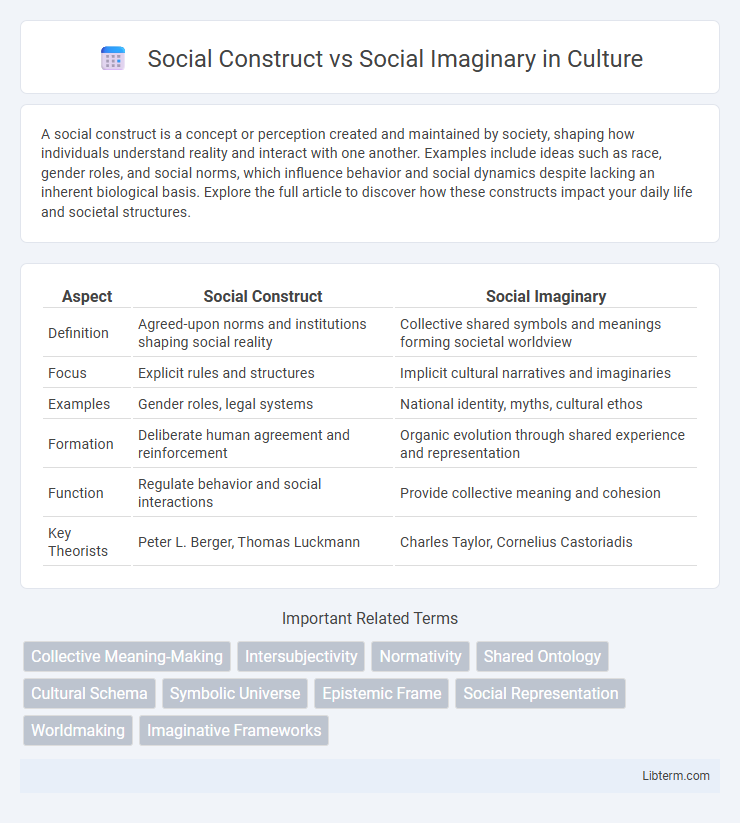A social construct is a concept or perception created and maintained by society, shaping how individuals understand reality and interact with one another. Examples include ideas such as race, gender roles, and social norms, which influence behavior and social dynamics despite lacking an inherent biological basis. Explore the full article to discover how these constructs impact your daily life and societal structures.
Table of Comparison
| Aspect | Social Construct | Social Imaginary |
|---|---|---|
| Definition | Agreed-upon norms and institutions shaping social reality | Collective shared symbols and meanings forming societal worldview |
| Focus | Explicit rules and structures | Implicit cultural narratives and imaginaries |
| Examples | Gender roles, legal systems | National identity, myths, cultural ethos |
| Formation | Deliberate human agreement and reinforcement | Organic evolution through shared experience and representation |
| Function | Regulate behavior and social interactions | Provide collective meaning and cohesion |
| Key Theorists | Peter L. Berger, Thomas Luckmann | Charles Taylor, Cornelius Castoriadis |
Introduction to Social Construct and Social Imaginary
Social constructs refer to concepts or perceptions created and maintained by societal consensus, shaping how individuals understand reality through shared beliefs and practices. Social imaginary encompasses the collective set of values, symbols, and narratives that people use to make sense of their social existence and guide their actions within a culture. Both frameworks influence social behavior, but social constructs emphasize agreed-upon definitions, while social imaginary highlights the broader, imaginative dimension of social understanding.
Defining Social Constructs
Social constructs are concepts or perceptions created and maintained through collective agreement within a society, shaping social reality and influencing behavior. These constructs, such as gender roles or money, exist because of shared understanding rather than inherent natural properties. Defining social constructs involves examining how cultural norms, language, and institutional practices contribute to their formation and persistence.
Understanding Social Imaginaries
Social imaginaries refer to the shared set of values, institutions, laws, and symbols through which people imagine their social existence, shaping collective identity and social order. Unlike social constructs, which are individual or group-created frameworks imposed on reality, social imaginaries operate as a broader, culturally embedded worldview that influences how societies perceive legitimacy and power structures. Understanding social imaginaries is essential for analyzing how social norms, political authority, and communal cohesion are maintained and transformed over time.
Historical Contexts of Each Concept
The concept of social construct emerged prominently in the mid-20th century, rooted in sociology and philosophy to explain how realities such as race, gender, and institutions are created through collective agreement and power dynamics. Social imaginary, developed earlier in the 20th century by thinkers like Cornelius Castoriadis and furthered by Charles Taylor, refers to the shared set of values, symbols, and narratives that shape how societies imagine their social existence. Historical contexts reveal social constructs as tools to analyze power relations and social stratification, while social imaginaries capture the evolving cultural frameworks that inform laws, identities, and collective meaning over time.
Key Theorists and Their Contributions
Social construct theory, notably advanced by Peter L. Berger and Thomas Luckmann in "The Social Construction of Reality" (1966), emphasizes how knowledge and reality are shaped through social interactions and shared meanings. Conversely, the social imaginary, extensively explored by Charles Taylor in "Modern Social Imaginaries" (2004), refers to the collective way societies imagine their social existence and understand their normative frameworks. Jurgen Habermas also contributed by linking these concepts to communicative action, highlighting how shared understandings underpin social cohesion and institutions.
Differences Between Social Construct and Social Imaginary
Social constructs are specific ideas or categories created and maintained through collective agreement, such as gender roles or currency, grounded in social practices and institutions. The social imaginary refers to the broader shared set of values, symbols, and meanings that shape how people perceive and engage with their social reality, often operating at a cultural or societal level. Differences between social construct and social imaginary lie in their scope and function: social constructs are tangible frameworks established through interaction, while the social imaginary comprises the underlying collective intuition and worldview that inform those constructs.
Overlaps and Intersections
Social constructs and the social imaginary intersect in shaping collective understanding by influencing how societies create and sustain shared meanings and norms. Both concepts rely on collective acceptance, with social constructs emphasizing defined agreements around concepts like race or gender, while the social imaginary encompasses broader narratives and symbols guiding social behavior and identity. Their overlap is evident in how imagined realities inform social structures, making societal norms both products of conceptual frameworks and collective imagination.
Real-World Examples of Social Constructs
Social constructs such as race, gender, and class shape societal interactions and power dynamics despite lacking inherent biological bases. For example, racial categories influence access to resources and legal treatment, while gender norms dictate behavior and occupational roles across cultures. These examples highlight how social realities are created and maintained through collective beliefs and institutional practices.
Social Imaginaries in Everyday Life
Social imaginaries shape everyday life by influencing how individuals collectively understand social norms, values, and institutions, guiding behavior and expectations within communities. These shared imaginaries create a framework for interpreting social reality, enabling people to cooperate and navigate complex social structures. Unlike social constructs, which are specific concepts or categories created through social agreement, social imaginaries encompass broader, collective ways of thinking that permeate daily interactions and cultural practices.
Implications for Society and Future Research
Social construct theory emphasizes how societal norms and institutions are created through collective agreement, shaping behavior and power dynamics, while social imaginary refers to the shared symbols, stories, and practices that constitute a group's worldview. Understanding the distinctions and overlaps between these concepts has profound implications for addressing social inequalities, guiding policy-making, and fostering inclusive dialogue. Future research should explore their interaction in digital environments and the impact of evolving technologies on collective meanings and social structures.
Social Construct Infographic

 libterm.com
libterm.com